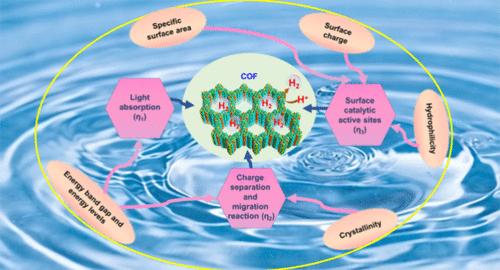当前位置:
X-MOL 学术
›
ACS Catal.
›
论文详情
Our official English website, www.x-mol.net, welcomes your
feedback! (Note: you will need to create a separate account there.)
Unraveling the Key Factors on Structure–Property–Activity Correlations for Photocatalytic Hydrogen Production of Covalent Organic Frameworks
ACS Catalysis ( IF 11.3 ) Pub Date : 2024-11-17 , DOI: 10.1021/acscatal.4c04968 Pengyu Dong, Cunxia Wang, Lihua Zhang, Jinkang Pan, Boyuan Zhang, Jinlong Zhang
ACS Catalysis ( IF 11.3 ) Pub Date : 2024-11-17 , DOI: 10.1021/acscatal.4c04968 Pengyu Dong, Cunxia Wang, Lihua Zhang, Jinkang Pan, Boyuan Zhang, Jinlong Zhang

|
It has been a challenging task to clearly elucidate various structural features and how their interactions affect the photocatalytic hydrogen production performance. In this work, various factors, including crystallinity, specific surface area associated with morphology, energy band gap and energy levels, surface charge, and hydrophilicity, were employed to investigate the structure–property–activity correlations of β-ketoenamine-linked covalent organic framework (TpPa-1-COF) for photocatalytic H2 production, which could influence the light harvesting, charge separation and transfer, and surface catalytic active sites. By using different methods to prepare TpPa-1-COFs, we can regulate these influencing factors to investigate their relationship with activity. It is found that the TpPa-1-COF prepared by a molecular organization method (labeled as TpPa-1 (MO)) exhibits the highest photocatalytic H2 evolution activity compared with the TpPa-1-COF samples prepared by solvothermal methods using acetic acid (HOAc) as a catalyst (TpPa-1 (ST-HOAc)) and KOH solution as a catalyst (TpPa-1 (ST-KOH)), which is associated with the highest crystallinity, the optimal energy levels, the largest BET-specific surface area, and the best hydrophilicity for TpPa-1 (MO). Moreover, our findings suggest that the enhanced total photocatalytic H2 evolution efficiency (ηtotal) of TpPa-1 (MO) may be mainly attributed to the efficient separation and migration of photogenerated charges (η2) and the vibrant surface catalytic active sites (η3). Overall, this work provides some deep insights into the structure–property–activity relation of TpPa-1-COF photocatalysts, which offers valuable inspiration and guidance for the thoughtful design of COF-based photocatalysts for H2 evolution.
中文翻译:

揭示共价有机框架光催化制氢的结构-性质-活性相关性的关键因素
清楚地阐明各种结构特征以及它们的相互作用如何影响光催化制氢性能一直是一项具有挑战性的任务。在这项工作中,采用结晶度、与形貌相关的比表面积、能带隙和能级、表面电荷和亲水性等各种因素来研究 β-酮烯胺连接的共价有机框架 (TpPa-1-COF) 在光催化 H2 生产中的结构-性质-活性相关性,这可能影响光收集、电荷分离和转移以及表面催化活性位点。通过使用不同的方法制备 TpPa-1-COFs,我们可以调节这些影响因素,以研究它们与活性的关系。研究发现,与使用乙酸 (HOAc) 作为催化剂 (TpPa-1 (ST-HOAc)) 和 KOH 溶液 (TpPa-1 (ST-KOH)) 通过溶剂热法制备的 TpPa-1-COF 样品相比,通过分子组织方法制备的 TpPa-1-COF (标记为 TpPa-1 (MO))表现出最高的光催化 H2 析出活性,它与最高的结晶度相关, TpPa-1 (MO) 的最佳能级、最大的 BET 比表面积和最佳亲水性。此外,我们的研究结果表明,TpPa-1 (MO) 增强的总光催化 H2 析出效率 (η总) 可能主要归因于光生电荷 (η2) 和充满活力的表面催化活性位点 (η3)。 总的来说,这项工作对 TpPa-1-COF 光催化剂的结构-性质-活性关系提供了一些深入的见解,为基于 COF 的光催化剂的 H2 演化设计提供了宝贵的灵感和指导。
更新日期:2024-11-18
中文翻译:

揭示共价有机框架光催化制氢的结构-性质-活性相关性的关键因素
清楚地阐明各种结构特征以及它们的相互作用如何影响光催化制氢性能一直是一项具有挑战性的任务。在这项工作中,采用结晶度、与形貌相关的比表面积、能带隙和能级、表面电荷和亲水性等各种因素来研究 β-酮烯胺连接的共价有机框架 (TpPa-1-COF) 在光催化 H2 生产中的结构-性质-活性相关性,这可能影响光收集、电荷分离和转移以及表面催化活性位点。通过使用不同的方法制备 TpPa-1-COFs,我们可以调节这些影响因素,以研究它们与活性的关系。研究发现,与使用乙酸 (HOAc) 作为催化剂 (TpPa-1 (ST-HOAc)) 和 KOH 溶液 (TpPa-1 (ST-KOH)) 通过溶剂热法制备的 TpPa-1-COF 样品相比,通过分子组织方法制备的 TpPa-1-COF (标记为 TpPa-1 (MO))表现出最高的光催化 H2 析出活性,它与最高的结晶度相关, TpPa-1 (MO) 的最佳能级、最大的 BET 比表面积和最佳亲水性。此外,我们的研究结果表明,TpPa-1 (MO) 增强的总光催化 H2 析出效率 (η总) 可能主要归因于光生电荷 (η2) 和充满活力的表面催化活性位点 (η3)。 总的来说,这项工作对 TpPa-1-COF 光催化剂的结构-性质-活性关系提供了一些深入的见解,为基于 COF 的光催化剂的 H2 演化设计提供了宝贵的灵感和指导。


















































 京公网安备 11010802027423号
京公网安备 11010802027423号